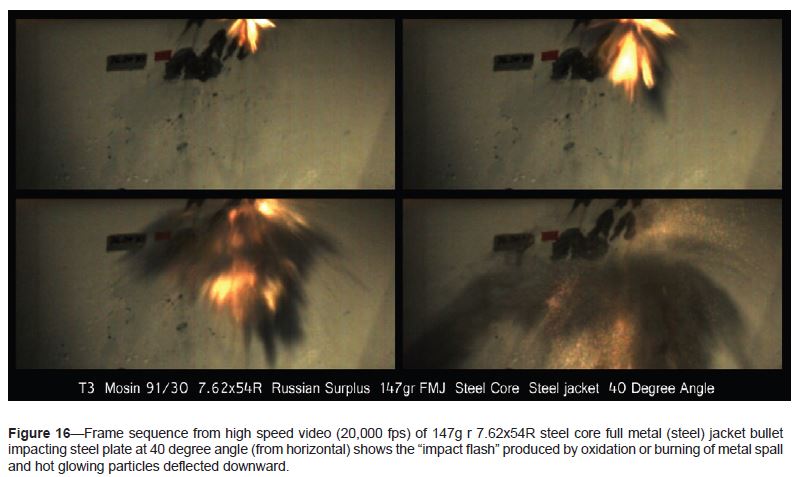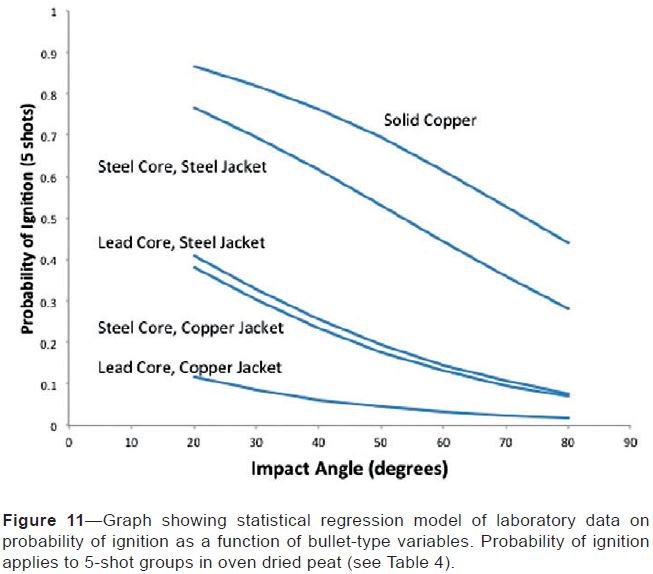 (Click the photo to see a larger version. These photos are from the research paper referenced below.)
(Click the photo to see a larger version. These photos are from the research paper referenced below.)
In research that was published in August, it was found that all types of rifle bullets studied were capable of starting fires in vegetation after being deflected by a steel plate. Fragments of most of the bullets that scientists at the U.S. Forest Service Rocky Mountain Research Station collected in a bed of peat moss reliably caused ignitions, specifically those containing steel components (core or jacket) and those made of solid copper. Lead core-copper jacketed bullets caused only one ignition in these tests. Solid copper bullets were the most consistent in producing ignitions at all angles and all targets.
Many wildfires are caused by target shooting, so it is helpful to have some actual data examining how they are ignited and by what type of ammunition. Lead core copper jacket bullets appear to have a low probability of starting fires.
While the military has conducted numerous studies on bullet fragmentation, this is the first time that researchers have looked at the probability of ignition (PI) in vegetation.
This research shows that fires can be ignited by hot fragments of the bullets due to the heat generated when the kinetic energy of the lead, copper, or steel is transformed to thermal energy by plastic deformation and fracturing from the high-strain rates during impact. Lead has a lower melting point than copper or steel, which contributes to the lower PI of lead core bullets.
In the study a high-speed video camera was used at frame rates of 8,000 to 100,000 frames per second to attempt to capture impact fragmentation and impact flash. Usually the camera was positioned from behind the bullet as it was fired. Researchers found that a camera placed in front of the bullet lasted only one series before being destroyed by a fragment.
The study was conducted by Mark A. Finney, Trevor B. Maynard, Sara S. McAllister, and Ian J. Grob.
Below is a video shot by a company that sells a 1,000,000 frame per second camera, showing bullets striking various objects. We are hoping to gain access to the video shot by the USFS researchers. If we do, we’ll post it here.
Thanks go out to Ken


I think this is great info. I always ASSUMED that many of these were as a result of the chosen targets (butane or propane containers, explosive targets and the like. This shows a different cause, good research.
Since copper is being touted as a replacement for lead hunting bullets, this research might be an example of unintended consequences of legislation.
Would be interesting to have numbers of fire starts, locations and activities involving bullet strikes.
I believe it would be helpful to put stress on two salient features: steel core or steel jacket, or solid copper, bullets, and the use of a steel plate as a target. People opposed to the use of firearms as a general matter seize on this type of research to try to claim that someone out hunting jackrabbits poses a meaningful fire hazard. I understand this can be an emotionally reactive, and politically divisive, issue and simply hope that the constraints of the study itself are born in mind. I also understand that out of a large user group, some people out target shooting do engage in different types of asshattery including things that are already prohibited, and don’t want to overlook the issue of how to address bad apples in the barrel, for any user group.